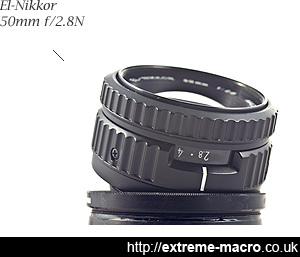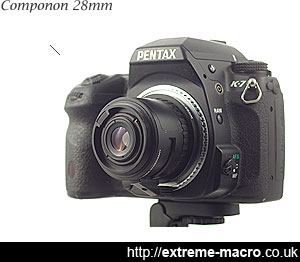Reversed Enlarger Lenses
by Johan J Ingles-Le Nobel
Last updated August 31, 2017
Reversed enlarger lenses are one of the mainstays of extreme macro photography, because they give exceptional flat field performance at extremely reasonable prices.
Enlarger Lens Prices
Since the emergence of digital photography, demand for enlargers has been drastically decreased, so the price you pay for enlarger lenses has come down radically over the years. There are some delicious bargains to be had out there.
One reason for the lower price is the condition of the lenses; mine are generally beat up with scratches and dust. But, even in this condition, my lenses are still extremely sharp. I have never paid more than £100 for any enlarger lens and most cost much less.
Nikon El-Nikkor 50mm f/2.8N, a cracking enlarger lens that performs beautifully and is easy to get hold of. This is an excellent choice for a first extreme macro enlarger lens.
Why Enlarger Lenses?
An enlarger lens is specifically designed to project light through a flat negative onto a sheet of printing paper. Therefore, if used in reverse, an enlarger lens is perfectly designed to project an image onto a flat digital sensor.
Reverse Or Not?
This is a question often asked about reversing enlarger lenses - is it really worth reversing them?
The basic rule of thumb is that asymmetrical lenses perform better if reversed, whereas with symmetrical lenses there is probably little visible difference, so there is no point.
The most visible differences would be in the periphery of the image, and are probably related to field flatness.
perfectly designed to project an image onto a flat digital sensorA flat test object such as graph paper can show them better than a real life shot of an 3D insect in the centre of the image where the resolution will be about the same and the field curvature is irrelevant.
In my own experience it seems to me that reversing is only better below 50mm.
Reversing enlarger lenses does one other important thing. Most enlarger lenses made a reverse mounted lens will give you more working room in the last 25 years have illuminated f-stops - a window on the back of the lens puts light into the numbers - and if you mount the lens near side to the bellows, light enters the numbers, exits the rear window, and causes a light leak in your image. Reversing your lens stops this problem.
Pentax K-7 with a Componon 28mm f/4, an outstanding lens for up to 5:1.
Mounting an enlarger lens in the regular way round requires an adapter from your bellows mount to M39 (the most common enlarger lens mount), which is difficult to find.
Reverse mounting an enlarger lens is done with an easy-to-find step-up ring and a relatively common reverse mount for the bellows.
Also, the back of an enlarger lens is typically smaller than the front, so a reverse mounted lens will give you more working room.
Which Enlarger Lenses?
I have never paid more than £100 for any enlarger lensOver the years thousands of enlarger lenses have been made, but not all enlarging lenses are equal, and it is all too easy to purchase a poor lens with the glut of enlarging lenses that's out there given the decline of the darkroom.
For extreme macro photography, the better enlarger lenses to use are six element enlarger lenses: cheaper four element variants do not perform especially well. Nikon El-Nikkor 50mm f/2.8N is such a six element lens and highly recommended.
Componons, Rodagons and El-Nikkors are usually used by extreme macro photographers, but I have also seen good things written about six element Fujinons.
Related Articles







